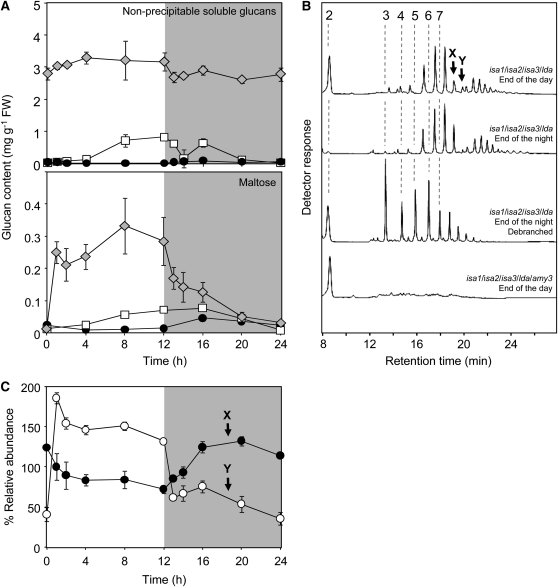Figure 6.
The Quadruple DBE Mutant Contains a Dynamic Pool of Soluble Malto-Oligosaccharides.
(A) Soluble malto-oligosaccharides (top panel) in wild-type (black circles), isa1/isa2 double mutant (white squares), and quadruple DBE mutant (gray diamonds) plants. Values were calculated by subtracting the methanol-precipitable phytoglycogen from the total pool of soluble glucans. In the quadruple DBE mutant, these glucans comprised maltose and a set of branched oligosaccharides. Maltose (bottom panel) was quantified by HPAEC-PAD.
(B) Representative chromatograms of malto-oligosaccharides present in extracts of the quadruple DBE mutant. Extracts were prepared from plants harvested at the end of the day and at the end of the night, as indicated. Note the difference in maltose content and that the larger oligosaccharides do not elute as linear oligosaccharides (elution times of linear glucans with d.p. 2 to 7 are indicated by dashed lines). Treatment of the end-of-night sample with Pseudomonas isoamylase and Klebsiella pullulanase results in smaller, linear malto-oligosaccharides and the appearance of maltose, showing that the oligosaccharides were branched. Extracts prepared from the isa1/isa2/isa3/lda/amy3 quintuple mutant leaves contain maltose but no branched oligosaccharides.
(C) Diurnal changes in the relative peak areas of branched malto-oligosaccharides of d.p. 9 (black circles) and d.p. 10 (white circles), designated X and Y, respectively, in the chromatograms in (B). As standards are not available for these malto-oligosaccharides, the peak areas at each time point were normalized to the average area for that peak over the diurnal cycle. Other peaks in the chromatograms displayed day/night changes in relative abundance, although generally smaller in magnitude.

